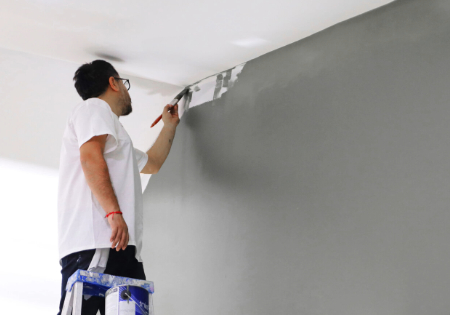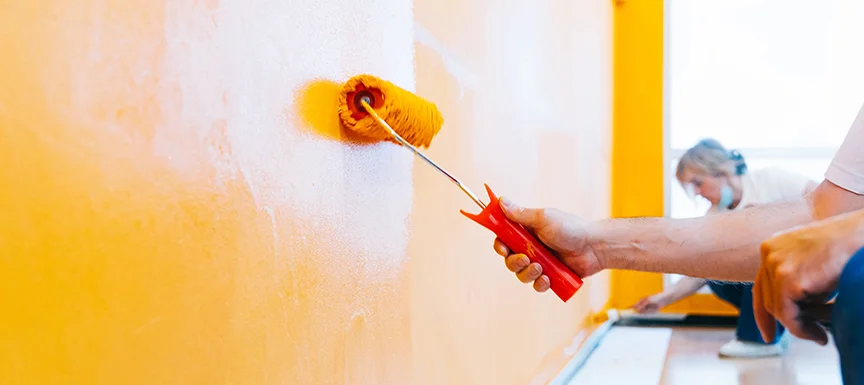Stay Ahead With New Paint Trends: Blending Techniques for Modern Interiors

The Increase of Shade Gradients in Interior Decoration
As developers significantly look for innovative means to enhance areas, the increase of color gradients in interior decoration has actually gathered considerable attention. This technique, identified by the smooth change between two or more shades, enables a dynamic aesthetic effect that can change an average area into a lively environment. Color slopes can evoke emotions, influence understandings of space, and develop prime focus, making them a functional choice for numerous design styles.
The application of slopes prolongs past walls; they can be efficiently used in furniture, textiles, and devices. Developers commonly trying out varying tones to achieve deepness and intrigue, appealing to a variety of looks from minimalist to eclectic. On top of that, the flexibility of gradients enables their usage in both residential and business settings, dealing with diverse clients. As trends advance, the use of shade slopes indicates a shift towards even more meaningful and customized interior rooms, showing private preferences and lifestyles.
Accepting Ombre Methods for a Dynamic Look
Ombre strategies have emerged as a charming selection for those looking to add depth and movement to modern-day interiors. This slope impact changes smoothly from one shade to another, producing a visually striking centerpiece in any type of room. Developers value ombre for its flexibility; it can be related to wall surfaces, furniture, or even attractive accents, allowing for one-of-a-kind expressions of design.
The technique functions especially well with soft tones, giving a calm ambiance, while bold shades can stimulate a space. Home owners can trying out various color palettes, picking different shades for a significant effect or harmonious tones for a subtle effect. The application of ombre is not limited to a single wall; it can prolong throughout an area, boosting the assumption of room and light.
As a contemporary trend, ombre techniques satisfy diverse preferences, permitting people to individualize their interiors and welcome creative thinking in their style approach. paint shops in corpus christi.
Textured Walls: Layering Paint for Deepness and Passion
Textured wall surfaces can significantly improve the aesthetic charm of contemporary insides by adding deepness and rate of interest. Techniques for producing structure, thoughtful shade combinations, and the right tools for layering are vital components in achieving this effect. Checking out these aspects permits for a personalized and dynamic method to interior decoration.
Methods for Appearance Creation
Developing aesthetic rate of interest in interior rooms usually rests on the artful application of texture. Numerous techniques can be employed to achieve this, such as sponging, cloth rolling, and stippling. Sponging includes making use of a moist sponge to use a second shade over a skim coat, developing a soft, varicolored impact. Dustcloth rolling, on the other hand, utilizes a rolled rag to apply paint, causing a much more vibrant structure. Stippling uses a stiff brush or tool to swab paint onto the surface area, creating a special pattern. Furthermore, layering various surfaces, such as matte and glossy, can improve depth. These techniques not only supply aesthetic appeal however also add to the total atmosphere of modern-day insides, encouraging a tactile experience.
Shade Mixes for Impact
Layering paint not only enhances texture however additionally opens a globe of color mixes that can significantly affect the mood of a room. By blending complementary shades, developers can create an unified result that welcomes heat or coolness, depending upon the desired environment. Abundant planet tones combined with soft pastels can stimulate a tranquil environment, while vibrant, different shades can include vibrancy and energy. Additionally, including shiny or metallic coatings within the layers can present a dynamic visual element, capturing light and improving the deepness of the shade plan. Ultimately, thoughtful color mixes through layering paint give a possibility to express individual style while transforming common walls right into bewitching focal factors.
Tools for Layering Result
Various tools are essential for achieving an effective layering result in paint applications, which can transform walls right into captivating visual experiences. Brushes and rollers are essential, with varied sizes enabling various appearances and coatings. Specialized devices like sponges and dustcloths can produce special patterns and depth, while palette blades supply precision for more specified lines. For larger locations, using a stippling brush can include a complex coating. Furthermore, spray guns can successfully use several layers for a smooth, even layer. Painters must also think about painter's tape to develop tidy edges between layers. By making use of the right tools, one can efficiently boost the visual allure of insides, making each wall an appealing prime focus.

The Power of Shade Blocking in Modern Spaces
As contemporary interior decoration remains to advance, color obstructing becomes an effective technique that can change rooms with strong visual influence. This approach entails the critical positioning of contrasting shades to produce specified areas within a room, enhancing both the aesthetic charm and performance of the room. benjamin moore paint store corpus christi. By utilizing large swathes of color, designers can lead the eye and read more emphasize architectural aspects, causing a dynamic environment
Color stopping is not restricted to walls; it can likewise be put on furnishings and decoration, enabling limitless customization. Pairing a lively color with a neutral tone can produce a striking focal factor while preserving equilibrium. This method urges creative thinking, enabling home owners to reveal their personalities via special shade combinations. Eventually, color obstructing works as an efficient way to revive contemporary interiors, making rooms feel fresh, energised, and visually interesting.
Integrating Metallics for an Extravagant End up
Just how can metallics raise the elegance of modern insides? Metallic finishes act as a striking prime focus, adding deepness and aesthetic rate of interest to spaces. They can transform a typical area right into a stylish retreat via the refined interplay of light and representation. Designers frequently recommend incorporating metallics in accent walls, ceilings, or furniture to produce an elegant environment without overwhelming the space.
Numerous metallic tones-- such as silver, bronze, and gold-- provide convenience, enabling home owners to customize their aesthetic. For example, a soft gold can give heat, while a streamlined silver can offer a modern touch. When paired with neutral tones, metallics boost the overall style, providing an innovative contrast that attracts the eye.
Incorporating metallic paint into trim or moldings can additionally boost architectural details, producing a sleek finish. Inevitably, the strategic usage of metallics can infuse modern-day interiors with beauty and improvement, making them truly bewitching.
Innovative Use Stencils for Special Patterns
Changing walls with stencils can instill modern-day insides with unique personality and style. This artistic technique allows developers and homeowners to create tailored patterns that mirror individual looks. Patterns can range from intricate geometric styles to whimsical motifs, making it possible for a wide range of expressions. By selecting different shades, patterns can raise a space's aesthetic allure and act as prime focus without frustrating the room.
Additionally, patterns are functional; they can be related to various surface areas, consisting of walls, furniture, and even ceilings. This versatility makes stenciling an optimal selection for do it yourself lovers wanting to improve their home cost effectively. Furthermore, the simplicity of application and elimination enables testing, enabling people to refresh their design with minimal initiative. Ultimately, creative usage of stencils not just changes regular surfaces however also supplies a chance for self-expression, making them a trending choice in contemporary interior decoration.
Blending Matte and Shiny Surfaces for Comparison
The interaction of matte and glossy coatings can produce a striking aesthetic dynamic in modern insides. Designers typically utilize this comparison to improve architectural features and specify spaces. Matte coatings, with their soft, non-reflective top quality, can produce a feeling of warmth and affection, making them suitable for walls and bigger surfaces. On the other hand, glossy coatings show light, including vibrancy and depth, making them ideal for accents such as trim, moldings, or furniture.
The mix of these textures can lead the eye and highlight prime focus within a space. For example, pairing a matte-painted wall surface with shiny cabinetry can produce a sophisticated equilibrium. Additionally, the cautious application of both finishes can evoke numerous moods while improving the general visual. As house owners increasingly seek individualized spaces, mixing matte and shiny coatings offers a versatile technique to attaining contemporary beauty and aesthetic interest in interior design.
Often Asked Questions
What Tools Are Best for Blending Paint Techniques?
A range of devices are perfect for mixing paint methods, consisting of foam rollers, brushes with soft bristles, sponge applicators, and airbrushes. Each tool supplies distinct results, improving the blending process for different creative applications.
Exactly How Can I Take Care Of Mixing Mistakes?
To fix blending mistakes, one should lightly sand the affected area, apply a primer if needed, and after that meticulously reapply paint utilizing a soft brush or sponge to attain a smooth change and bring back the preferred effect.
Are There Particular Paint Brands Recommended for Blending?
Several paint brands are recommended for blending, consisting of Benjamin Moore, Sherwin-Williams, and Behr. These brand names provide high-quality coatings and a wide variety of shades that promote smooth shifts and effective mixing techniques in numerous indoor projects.
Can I Mix Paint Without Specialist Aid?
Yes, mixing paint without expert aid is possible. With technique and the right tools, individuals can accomplish desirable impacts. Different online tutorials and overviews can help in grasping blending strategies for personal jobs.

How Lengthy Does Blended Paint Last on Wall Surfaces?
Mixed paint can last anywhere from 5 to 10 years on wall surfaces, depending on aspects such as the high quality of paint made use of, surface prep work, and ecological problems. Regular maintenance commonly enhances longevity and look.
As developers progressively seek cutting-edge means to boost areas, the increase of shade slopes in interior layout has amassed considerable attention. The technique works especially well with soft shades, supplying a tranquil setting, while vibrant colors can energize a space. Techniques for creating appearance, thoughtful color mixes, and the right tools for layering are essential parts in attaining this result. Layering paint not just improves structure but additionally opens up a globe of color combinations that can dramatically influence the mood of a room. As modern indoor style continues to evolve, shade blocking arises as an effective method that can transform rooms with strong visual influence.